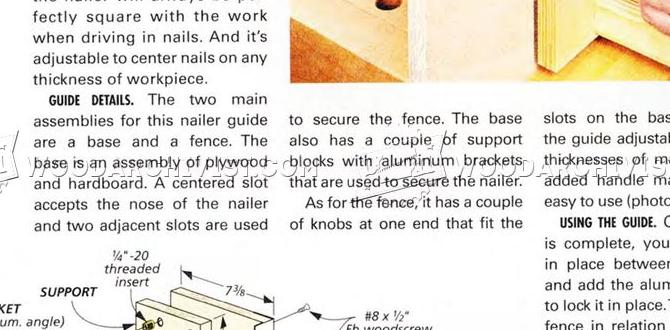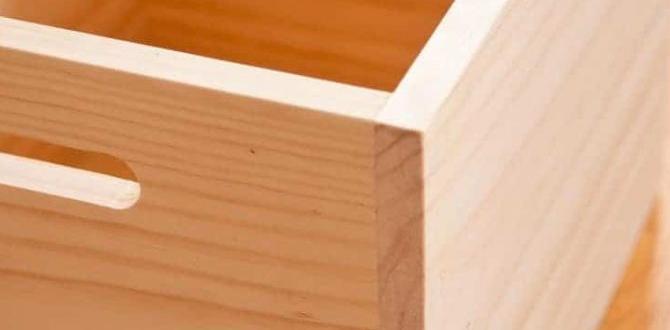Have you ever thought about making something with your own hands? Woodworking can turn your dreams into reality. It’s about creating beautiful items from wood. From simple shelves to stunning furniture, the possibilities are endless! But where do you start?
This article will guide you through the basics of how to start woodworking. You’ll find tips and tricks that even beginners can use. Imagine the pride you’ll feel when you finish your first project!
Did you know that woodworking is one of the oldest trades in the world? People have crafted amazing things from wood for thousands of years. With the right tools and guidance, you can join this creative journey too.
So, are you ready to discover the beginner’s blueprint for woodworking? Let’s chop away the confusion and dive in!
Table of Contents
How To Start Woodworking: A Beginner’S Blueprint Guide
Starting woodworking can be exciting and fun. Begin by choosing the right tools, like a hammer and saw. Understanding wood types helps too. Did you know that pine is one of the easiest woods to work with? Safety is key. Always wear protective gear. Set small goals, like making a simple shelf. This will build your confidence. Soon, you’ll enjoy creating unique projects that impress friends. Ready to start your woodworking journey?
Choosing the Right Wood for Your Projects
Different types of wood and their characteristics. Tips for purchasing wood on a budget.
Choosing wood can feel like picking a favorite pizza topping—so many options! Different woods act differently. Softwoods, like pine, are light and easy to cut. Hardwoods, like oak, are sturdy and last long. On a budget? Look for salvage yards or local suppliers; they often offer great deals. Remember, quality wood is an investment! Here’s a quick comparison:
| Type of Wood | Characteristics |
|---|---|
| Softwood (e.g., Pine) | Light, easy to work, good for beginners |
| Hardwood (e.g., Oak) | Durable, ideal for furniture, may cost more |
Picking the right wood can turn your projects from ‘meh’ to ‘wow! Happy woodworking!
Safety Practices in Woodworking
Importance of safety gear and personal protective equipment. Common safety tips and best practices.
Woodworking can be fun, but safety is first! Always wear proper safety gear like goggles and gloves. These help protect your eyes and hands from sharp tools and flying wood pieces. Follow these important safety tips:
- Keep your workspace clean and organized.
- Always cut away from your body.
- Don’t rush; take your time with each task.
- Make sure tools are in good shape.
Remember, safety practices can help you enjoy woodworking without accidents!
What safety gear do I need for woodworking?
You need goggles, ear protection, and gloves to stay safe. These tools protect your eyes, ears, and hands while you make awesome wood projects!
Stay safe, work smart, and have fun!
Learning Resources and Communities
Recommended books, websites, and video tutorials. Joining local woodworking clubs and online communities.
Woodworking can be more fun with the right resources! Start by checking out some recommended books and websites. Books like “The Complete Manual of Woodworking” and websites such as FineWoodworking.com offer great tips and ideas. Video tutorials on platforms like YouTube show you step-by-step techniques.
Joining local woodworking clubs is also a great way to learn. You can meet experienced woodworkers and share ideas. Online communities can provide support and inspiration. Connecting with others makes learning exciting!
What are good resources for beginner woodworkers?
Useful resources include books, websites, and video tutorials. Joining a community can also help. Local woodworking clubs and online groups are great for sharing tips.
Helpful Resources:
- Books: “The Complete Manual of Woodworking”
- Websites: FineWoodworking.com
- Video Tutorials: YouTube channels on woodworking
- Communities: Local clubs and online forums
Maintaining Your Tools and Workspace
Tips for caring for and storing tools. Organizing your workspace for efficiency.
Keeping your tools and workspace in good shape is important for any beginner woodworker. Here are some helpful tips:
- Always clean your tools after each use. This helps them last longer.
- Store tools in a dry place. Moisture can cause rust.
- Organize your workspace. Use shelves and pegboards to keep tools accessible.
- Label everything. Knowing where tools are saves time.
A clean and organized space can spark creativity. So, take care of your tools and enjoy woodworking!
How can I care for my woodworking tools?
To care for your woodworking tools, clean them after each use and store them in a dry place. Proper storage helps avoid rust and damage, keeping tools ready for your next project.
Conclusion
In conclusion, starting woodworking is fun and rewarding. Gather your tools, choose simple projects, and practice your skills. Remember to stay safe and follow instructions carefully. We all learn at our own pace, so don’t rush. Keep exploring resources, like books and videos, to expand your knowledge. Now, it’s time for you to start creating!
FAQs
What Essential Tools Do I Need To Start Woodworking As A Beginner?
To start woodworking, you need a few basic tools. First, get a handsaw to cut wood. A tape measure helps you measure pieces accurately. You should also have a hammer to drive in nails and a pair of safety goggles to protect your eyes. Lastly, a block of sandpaper will smooth out rough edges.
How Do I Choose The Right Type Of Wood For My First Woodworking Project?
To choose the right wood for your first project, think about what you want to make. Softwoods, like pine, are easy to use and great for beginners. They are lighter and cheaper. Hardwoods, like oak, are tougher but harder to cut. Decide what you like and what will work best for your project.
What Basic Safety Precautions Should I Take While Working With Woodworking Tools?
When working with woodworking tools, you should always wear safety glasses to protect your eyes. Use ear protection to keep your ears safe from loud noises. Always keep your fingers away from cutting edges. Make sure your workspace is clean and free from clutter. Lastly, follow the tool’s instructions carefully to stay safe.
Are There Any Beginner-Friendly Woodworking Projects That I Can Start With?
Yes! You can start with simple projects like a birdhouse or a small shelf. You can also make a picture frame or a simple bench. These projects use easy tools and materials. Remember to always ask an adult for help!
How Can I Learn Woodworking Techniques And Improve My Skills Over Time?
To learn woodworking, start by reading books or watching videos about it. You can also take classes with a teacher to learn hands-on. Practice your skills by making small projects, like a birdhouse or a shelf. Ask for feedback from friends or family to improve. Keep trying new things, and soon you’ll get better!






